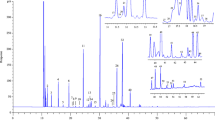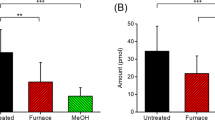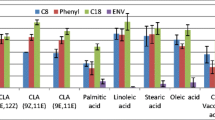Abstract
Low-temperature gas-liquid chromatography (GLC) was applied to study the distribution profiles of isomeric trans-and cis-hexadecenoic acids in ruminant (cow, goat, and ewe) milk fat after their fractionation by argentation thin-layer chromatography (Ag-TLC). The fat was extracted from cheeses (12 samples of each species), the most common foods made with goat and ewe milks. The predominant trans-16∶1 isomer is palmitelaidic acid (the Δ9 isomer), but it does not exceed one-third of the total group, which itself represents 0.17% (cow), 0.16% (goat), and 0.26% (ewe) of the total fatty acids. The trans-Δ3 16∶1 isomer, which is reported for the first time in ruminant lipids and which likely comes from the animals' feed, is present at a level of ca. 10% of the trans-16∶1 acid group. Otherwise, all isomers with their ethylenic bond between positions Δ4 and Δ14 are observed in the three species studied, roughly showing the same relative distribution pattern. Quantitatively, the trans-16∶1 isomers only represent ca. 5% of the sum of the trans-16∶1 plus trans-18∶1 isomers, and they appear of little importance in comparison. It is inferred from this and recent studies that some previously reported data that were established for consumption assessments dealt in fact mainly with iso-17∶0 acid, which was confused with (and added to) trans-Δ9 (palmitelaidic) acid; consequently, these results were large overestimates. Regarding the cis-16∶1 acids, the Δ9 isomer is the prominent constituent as expected, but the second-most important isomer is the Δ13 isomer. It does not appear that trans-16∶1 isomers are from ruminant milk fats of great nutritional importance as compared with trans-18∶1 isomeric acids. As for trans-18∶1 isomers, the combination Ag-TLC/GLC is a necessary procedure to quantitate trans-16∶1 acids accurately and reliably. Ag-TLC allows removal of interfering branched 17∶0 acids and cis-16∶1 acids, and low-temperature GLC permits an accurate measurement of all individual isomers most of which with baseline resolution.
Similar content being viewed by others
Abbreviations
- Ag-TLC:
-
argemation thin-layer chromatography
- FAME:
-
fatty acid methyl ester
- FFA:
-
free fatty acid
- GLC:
-
gas-liquid chromatography
- TMSH:
-
trimethyl sulfonium hydroxide
References
Thomas, L.H., and Winter, J.A. (1987) Ischaemic Heart Disease and Consumption of Hydrogenated Marine Oils, Hum. Nutr.: Food Sci. Nutr. 41F, 153–165.
Thomas, L.H., Olpin, S.O., Scott, R.G., and Wilkins, M.P. (1987) Coronary Heart Disease and the Composition of Adipose Tissue Taken at Biopsy, Hum. Nutr.: Food Sci. Nutr. 41F, 167–172.
Molkentin, J., and Precht, D. (1997) Occurrence of trans-C16∶1 Acids in Bovine Milkfats and Partially Hydrogenated Edible Fats, Milchwissenschaft 52, 380–385.
Hay, J.D., and Morrison, W.R. (1970) Isomeric Monoenoic Fatty Acids in Bovine Milk Fat, Biochim. Biophys. Acta 202, 237–243.
Hay, J.D., and Morrison, W.R. (1973) Positional Isomers of cis and trans Monoenoic Fatty Acids from Ox (steer) Perinephric Fat, Lipids 8, 94–95.
Ackman, R.G., and Macpherson, E.J. (1994) Coincidence of cis-and trans-Monoethylenic Fatty Acids Simplifies the Open-Tubular Gas-Liquid Chromatography of Butyl Esters of Butter Fatty Acids, Food Chem. 50, 45–52.
Wolff, R.L. (1994) Contribution of trans-18∶1 Acids from Ruminant Fats to European Diets, J. Am. Oil Chem. Soc. 71, 277–283.
Alonso, L., Fontecha, J., Lozada, L., Fraga, M.J., and Juarez, M. (1999) Fatty Acid Composition of Caprine Milk: Major, Branched-Chain, and trans Fatty Acids, J. Dairy Sci. 82, 878–884.
Precht, D., and Molkentin, J. (1999) C18∶1, C18∶2 and C18∶3 trans and cis Fatty Acid Isomers Including Conjugated cis Δ9, trans Δ11 Linoleic Acid (CLA) as Well as Total Fat Composition of German Human Milk Lipids, Nahrung 43, 233–244.
Precht, D., and Molkentin, J. (2000) Identification and Quantitation of cis/trans-16∶1 and −17∶1 Fatty Acid Positional Isomers in German Human Milk Lipids by TLC-Gas Chromatography-Mass Spectrometry, Eur. J. Lipid Sci. Technol. 102, 102–113.
Wolff, R.L. (1995) Content and Distribution of trans-18∶1 Acids in Ruminant Milk and Meat Fats. Their Importance in European Diets and Their Effect on Human Milk, J. Am. Oil Chem. Soc. 72, 259–272.
Wolff, R.L., Precht, D., and Molkentin, J. (1998) Trans-18∶1 Acid Content and Profile in Human Milk Lipids. Critical Survey of Data in Connection with Analytical Methods, J. Am. Oil Chem. Soc. 75, 661–671.
Precht, D. (1990) Quantitativer Nachweis von Milchfett in Schokolademischungen I: Bestimmung von Milchfettanteilen in Kakaobutter, Fat Sci. Technol. 92, 153–161.
Aro, A., Antoine, J.M., Pizzoferrato, L., Reykdal, O., and van Poppel, G. (1998) Trans Fatty Acids in Dairy and Meat Products from 14 European Countries: The TRANSFAIR Study, J. Food Comp. Anal. 11, 150–160.
Ohnishi, M., and Thompson, G.A., Jr. (1991) Biosynthesis of the Unique trans Δ3-Hexadecenoic Acid Component of Chloroplast Phosphatidylglycerol: Evidence Concerning Its Site and Mechanism of Formation, Arch. Biochem. Biophys. 288, 591–599.
Wolff, R.L., Bayard, C.C., and Fabien, R.J. (1995) Evaluation of Sequential Methods for the Determination of Butterfat Fatty Acid Composition with Emphasis on trans-18∶1 Acids. Application to the Study of Seasonal Variations in French Butters, J. Am. Oil Chem. Soc. 72, 1471–1483.
International Dairy Federation (1989) IDF Standard 6B: Determination of Fatty Acid, IDF, Brussels, Belgium.
Molkentin, J., and Precht, D. (1996) Isomeric Distribution and Rapid Determination of trans-Octadecenoic Acids in German Brands of Partially Hydrogenated Edible Fats, Nahrung 40, 297–304.
Gunstone, F.D., Ismail, I.A., and Lie Ken Jie, M.S.F. (1967) Thin-Layer and Gas-Liquid Chromatographic Properties of the cis and trans Methyl Octadecenoates and of Some Acetylenic Esters, Lipids 1, 376–385.
Folch, J., Lees, M., and Sloane-Stanley, G.M. (1957) A Simple Method for the Isolation and Purification of Total Lipids from Animal Tissues, J. Biol. Chem. 226, 497–509.
Lamberto, M., and Ackman, R.G. (1994) Confirmation by Gas Chromatography/Mass Spectrometry of Two Unusual trans-3-Monoethylenic Fatty Acids from the Nova Scotian Seaweed Palmaria palmata and Chondrus crispus, Lipids 29, 441–444.
Weenink, R.O., and Shorland, F.B. (1964) The Isolation of trans-3-Hexadecenoic Acid from the Lipids of Red-Clover (Trifolium pratense) Leaves, Biochim. Biophys. Acta 84, 613–614.
Kemp, P., White, R.W., and Lander, D.J. (1975) The Hydrogenation of Unsaturated Fatty Acids by Five Bacterial Isolates from the Sheep Rumen, Including a New Species, J. Gen. Microbiol. 90, 100–114.
Leth, T., Ovesen, L., and Hansen, K. (1998) Fatty Acid Composition of Meat from Ruminants, with Special Emphasis on trans Fatty Acids, J. Am. Oil Chem. Soc. 75, 1001–1005.
Wolff, R.L., Combe, N.A., Destaillats, F., Boué, C., Precht, D., Molkentin, J., and Entressangles, B. (2000) Follow-Up of the Δ4 to Δ16 trans-18∶1 Isomer Profile and Content in French Processed Foods Containing Partially Hydrogenated Vegetable Oils During the Period 1995–1999. Analytical and Nutritional Implications, Lipids 35, in press.
Wolff, R.L., Combe, N.A., Precht, D., Molkentin, J., and Ratnayake, W.M.N. (1998) Accurate Determination of trans-18∶1 Isomers by Capillary Gas-Liquid Chromatography on Cyanoalkyl Polysiloxane Stationary Phases, Oléagineux, Corps Gras, Lipides 5, 295–299.
Hulshof, K.F., van Erp-Baart, M.A., Anttolainen, M., Becker, W., Church, S.M., Couet, C., Hermann-Kunz, E., Kesteloot, H., Leth, T., Martins, I. et al. (1999) Intake of Fatty Acids in Western Europe with Emphasis on trans Fatty Acids: The TRANS-FAIR Study, Eur. J. Clin. Nutr. 53, 143–157.
Combe, N.A., Billeaud, C., Mazette, S., Entressangles, B., and Sandler, B. (1995) Trans Fatty Acids (TFA) in Human Milk Reflect Animal or Vegetable TFA Consumption in France, Pediatric Res. 37, 304A (abstract).
Combe, N., Judde, A., Boué, C., Billeaud, C., Entressangles, B., Dallay, D., Leng, J.J., and Baste, J.C. (1998) Composition en Acides Gras trans du Tissue Adipeux d'une Population Française et Origines Alimentaires de ces Acides Gras trans, Oléagineux, Corps Gras, Lipides 5, 142–148.
Author information
Authors and Affiliations
Corresponding author
About this article
Cite this article
Destaillats, F., Wolff, R.L., Precht, D. et al. Study of individual trans- and cis-16∶1 isomers in cow, goat, and ewe cheese fats by gas-liquid chromatography with emphasis on the trans-Δ3 isomer. Lipids 35, 1027–1032 (2000). https://doi.org/10.1007/s11745-000-0614-y
Received:
Revised:
Accepted:
Issue Date:
DOI: https://doi.org/10.1007/s11745-000-0614-y




